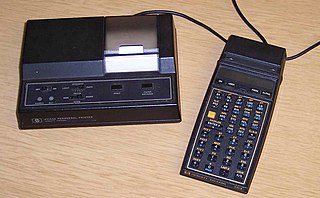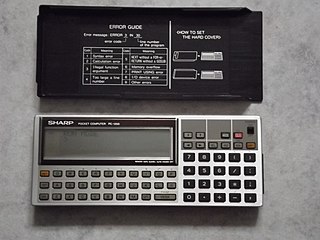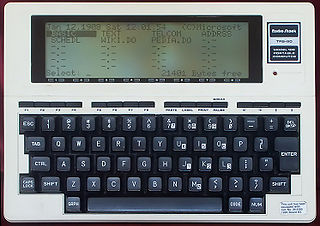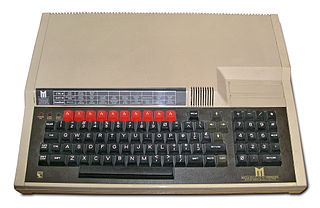
Casio Cassiopeia was the brand name of a PDA manufactured by Casio. It used Windows CE as the Operating system. Casio was one of the first manufacturers of PDAs, developing at the beginning small pocket-sized computers with keyboards and grayscale displays and subsequently moving to smaller units in response to customer demand.

The HP-41C series are programmable, expandable, continuous memory handheld RPN calculators made by Hewlett-Packard from 1979 to 1990. The original model, HP-41C, was the first of its kind to offer alphanumeric display capabilities. Later came the HP-41CV and HP-41CX, offering more memory and functionality.

The Sharp PC-1350 is a small pocket computer manufactured by Sharp. The PC-1350 was introduced in 1984 and was used by engineers, and favored by programmers for its programming and graphical capabilities. It was superseded in 1987 by the PC-1360, which featured one additional RAM expansion port, improved BASIC, floppy disk capability, and a faster CPU.

The Sharp PC-1403 was a small scientific calculator and pocket computer manufactured by Sharp. It was the successor of the Sharp PC-1401, and had better display, more RAM and better system software.

The Sharp PC-1500 was a pocket computer produced by Sharp during 1981-1985. A rebadged version was also sold as the TRS-80 Pocket Computer PC-2.

The Sharp PC-1401 is a small pocket computer manufactured by Sharp. It was introduced in 1983 and is one of the first combinations of scientific calculator and portable computer with BASIC interpreter/bytecode compiler. The PC-1402 has the same features but includes 10K of RAM.

The Sharp PC-1211 is a pocket computer marketed by Sharp Corporation in the 1980s. The computer was powered by two 4-bit CPUs laid out in power-saving CMOS circuitry. One acted as the main CPU, the other dealt with the input/output and display interface. Users could write computer programs in BASIC.

The Tandy Pocket Computer or TRS-80 Pocket Computer is one of a line of 1980s small pocket computers—calculator-sized programmable computing devices—sold by Tandy Corporation under the "Tandy" or "Radio Shack TRS-80" brands.

The TRS-80 Model 100 is a portable computer introduced in 1983. It is one of the first notebook-style computers, featuring a keyboard and liquid crystal display, in a battery-powered package roughly the size and shape of a notepad or large book.

The BBC Master is a home computer released by Acorn Computers in early 1986. It was designed and built for the British Broadcasting Corporation (BBC) and was the successor to the BBC Micro Model B. The Master 128 remained in production until 1993.
Programmable calculators are calculators that can automatically carry out a sequence of operations under control of a stored program, much like a computer. The first programmable calculators such as the IBM CPC used punched cards or other media for program storage. Hand-held electronic calculators store programs on magnetic strips, removable read-only memory cartridges, flash memory, or in battery-backed read/write memory.

The Sharp MZ is a series of personal computers sold in Japan and Europe by Sharp beginning in 1978.

The Jornada was a line of personal digital assistants or PDAs manufactured by Hewlett-Packard. The Jornada was a broad product line that included Palm-Size PCs, Handheld PCs, and Pocket PCs. The first model was the 820, released in 1998, and the last was the 928 model in 2002 when Compaq and HP merged. The Jornada line was then succeeded by the more popular iPAQ model PDAs. All Jornada models ran Microsoft Operating Systems that were based on Windows CE.

The Sharp PC-E500S was a 1995 pocket computer by Sharp Corporation and was the successor to the 1989 PC-E500 model, featuring a 2.304 MHz CMOS CPU.

The MobilePro is a discontinued line of personal digital assistants manufactured by NEC. Most models in the MobilePro range were handheld PCs with almost full size keyboards and a compact form placing them between being a palmtop and a subnotebook. All of the models in the MobilePro range ran a version of Microsoft's Windows CE mobile operating system and could be navigated using a stylus and touchscreen.

The Dick Smith Super-80 was a Zilog Z80 based kit computer developed as a joint venture between Electronics Australia magazine and Dick Smith Electronics. It was presented as a series of construction articles in Electronics Australia magazine's August, September and October 1981 issues.
Each time Intel launched a new microprocessor, they simultaneously provided a System Development Kit (SDK) allowing engineers, university students, and others to familiarise themselves with the new processor's concepts and features. The SDK single-board computers allowed the user to enter object code from a keyboard or upload it through a communication port, and then test run the code. The SDK boards provided a system monitor ROM to operate the keyboard and other interfaces. Kits varied in their specific features but generally offered optional memory and interface configurations, a serial terminal link, audio cassette storage, and EPROM program memory. Intel's Intellec development system could download code to the SDK boards.

The Sharp PC-E220 was a 1991 pocket computer from Sharp Corporation featuring 32 KB RAM, 128 KB ROM and a 3.072 MHz CMOS-SC7852 CPU which was Z80A compatible. The display was able to display 4 lines x 24 characters/144 x 32 pixels. Programming languages were BASIC and Z80-Assembler.
The Sharp pocket computer character sets are a number of 8-bit character sets used by various Sharp pocket computers and calculators in the 1980s and mid 1990s.
















